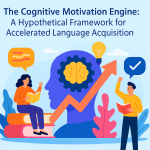Mentolinguism is a teaching method that leverages mental and subconscious processes, like ideomotor responses and intuitive cognition, to enhance English language learning. By blending mentalism and linguistics, it fosters a more natural approach to language mastery through subconscious engagement. While mentalism is often linked to entertainment, its psychological principles have practical applications in education. Teachers can use these techniques to create memorable, engaging classroom experiences. Ideomotor responses, subtle movements driven by subconscious thoughts, offer a novel way to boost participation and deepen language acquisition.
The Magic of Engagement: Turning Routine into Riveting
By integrating psychology, suggestion, and a touch of theatricality, educators can harness mentalism techniques to stimulate curiosity. Students, immersed in the process, experience heightened motivation and engagement, leading to improved language retention. The key lies in creating moments of wonder that break from the ordinary, sparking a genuine enthusiasm for learning English.
The Power of Suggestion: Leveraging the Subconscious
Mentalism isn’t about trickery—it’s about understanding the powerful influence of suggestion on the mind. Teachers who employ mentalism in the classroom can guide students to success by using subtle cues and ideomotor responses. For instance, a teacher might raise an eyebrow or change the tone of their voice just enough to nudge students toward the correct answer. The effect is subtle, but powerful, creating a learning environment where students feel supported and encouraged to explore language more freely.
This approach transforms learning from a passive process into an active, subconscious engagement. Students are not just processing words and grammar rules—they are physically and emotionally involved in their language development. By accessing these deeper mental pathways, educators can help students internalize new concepts more effectively.
Teacher Tells: Unlocking the Hidden Language of the Classroom
In the high-energy atmosphere of a classroom, both students and teachers are constantly giving off subtle, often unnoticed, signals. Teacher tells, like ideomotor responses, are unconscious movements or behaviors that can reveal a teacher’s thoughts or emotions. A slight change in posture, a quick glance, or a shift in vocal tone can communicate far more than words alone. Students, often without realizing it, pick up on these tells, adjusting their own behavior in response.
For educators, mastering the art of reading both their own and their students’ ideomotor cues is a critical skill. By understanding how to read a student’s reactions—whether through facial expressions, posture, or micro-movements—teachers can tailor their teaching methods in real-time, ensuring better understanding and engagement. Additionally, being aware of one’s own tells helps maintain control over the classroom atmosphere, preventing unintended cues from undermining authority or focus.
The Subtle Art of Connection
At its core, mentalism in education is about building a deeper connection between the teacher and students. By recognizing and responding to subconscious signals that both parties give off, teachers can foster a classroom environment that feels supportive, engaging, and intellectually stimulating. This approach doesn’t just improve language learning outcomes; it creates a space where students are eager to participate, knowing that their contributions are recognized and valued.
To better illustrate how mentalism can be applied practically, let’s explore some specific examples.
- Grammar Instruction: Teachers can use mentalism techniques during grammar lessons by leveraging ideomotor responses to guide students toward correct sentence structures. For instance, when teaching verb tenses, a teacher might use subtle physical gestures or pauses to suggest the right answer without explicitly stating it, encouraging students to “discover” the correct tense themselves. This could be especially helpful in activities like error correction, where students might be nudged toward identifying and correcting their own mistakes, enhancing their autonomy and critical thinking.
- Vocabulary Acquisition: For vocabulary learning, mentalism techniques can help make new words memorable. One method might involve pairing new vocabulary with strong, evocative imagery or metaphors. For example, when teaching a word like “resilient,” the teacher might evoke a powerful mental image of a tree bending in the wind but never breaking. By guiding students to visualize such metaphors, the learning process becomes more vivid, helping retention. Ideomotor cues might also be used when asking students to choose the correct word from a set of options. A slight nod or eye movement could steer them toward the right choice, reinforcing learning through subtle suggestion.
- Communication Skills: In practicing conversation, mentalism can foster confidence in speaking. For instance, a teacher could use suggestion to build up a student’s self-assurance before engaging in role-playing exercises. The teacher might “read” the student’s mind by predicting what they might say next, creating a playful and encouraging environment that boosts self-esteem. This type of interaction can ease the anxiety that often accompanies speaking practice, helping students feel more comfortable expressing themselves.
Addressing Concerns About Manipulation
While mentalism offers exciting possibilities, some educators may be wary of using such techniques, fearing that they could border on manipulation or lead to unintended consequences. However, it’s essential to emphasize that mentalism in the classroom should be used ethically and transparently. The goal is not to manipulate students into predetermined responses but to create a supportive atmosphere where they can engage more deeply with the material. Teachers can reassure students by explaining how certain techniques are designed to aid learning, making the process collaborative rather than controlling.
Additionally, mentalism should be employed as an enhancement to traditional teaching methods, not a replacement. The goal is to encourage active participation, spark curiosity, and guide students to their own conclusions, reinforcing autonomy in the learning process. Proper use of these techniques requires sensitivity and a keen understanding of students’ needs.
Research-Based Evidence
The potential effectiveness of mentalism techniques in education is supported by research in psychology and pedagogy. Studies on suggestion and subconscious learning show that subtle cues can significantly influence behavior and decision-making, even without conscious awareness. According to research on the Pygmalion effect, teachers’ expectations and subtle behaviors can positively impact student performance, suggesting that mentalism techniques might tap into similar mechanisms .
In language learning, constructivist theories emphasize the importance of students constructing their own knowledge, with teachers acting as facilitators rather than directors. Mentalism techniques align well with this approach, as they encourage students to arrive at answers on their own through subtle guidance rather than overt instruction .
Further case studies or classroom trials could shed more light on how mentalism impacts engagement and retention in language education. Research into affective filter theory—which states that emotions such as anxiety or confidence can influence language acquisition—suggests that techniques fostering a sense of wonder and excitement might lower barriers to learning, making mentalism an even more valuable tool for educators .
In conclusion, incorporating mentalism into language teaching offers a unique and powerful way to enhance learning. With specific applications in grammar, vocabulary, and communication skills, these techniques can transform routine lessons into immersive experiences. By addressing concerns about ethical use and grounding the approach in research, teachers can confidently use mentalism to foster curiosity, autonomy, and a deeper connection to the language-learning process.
Research more on Using Ideomotor Responses in ELT



